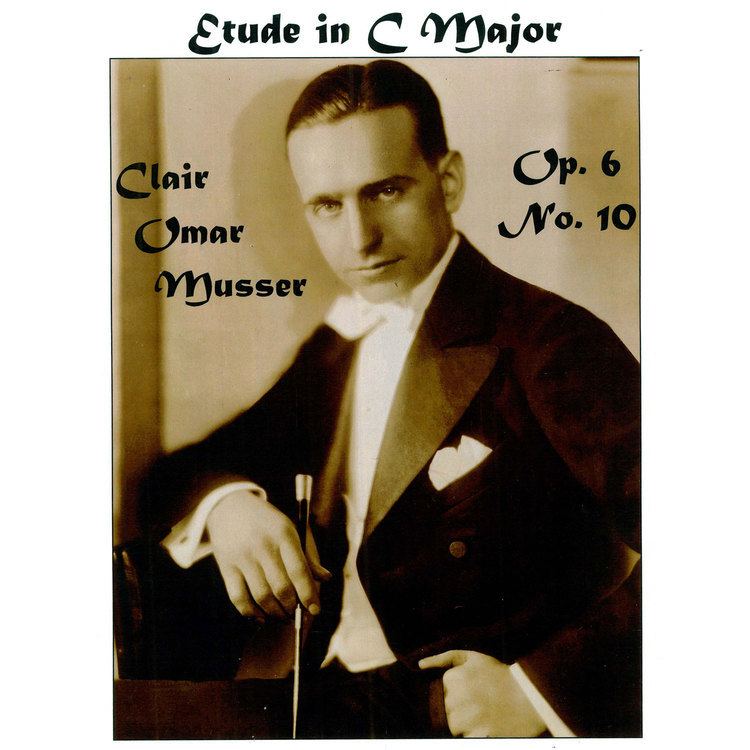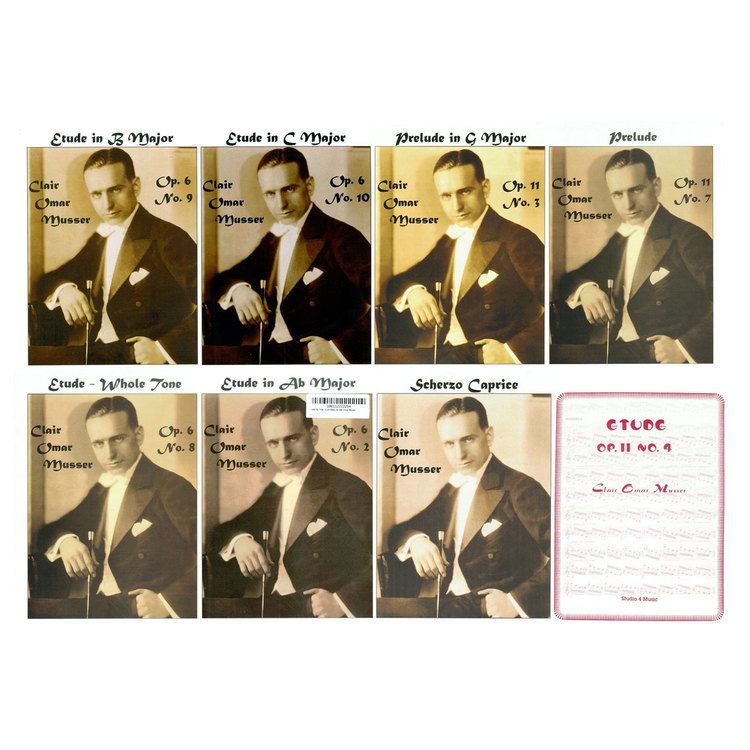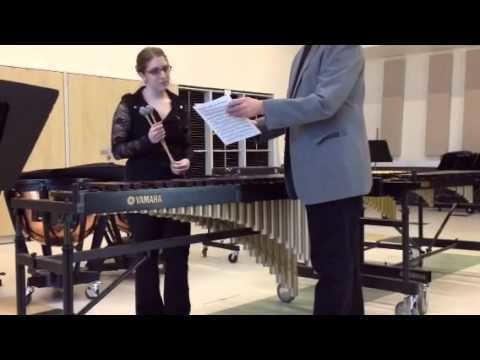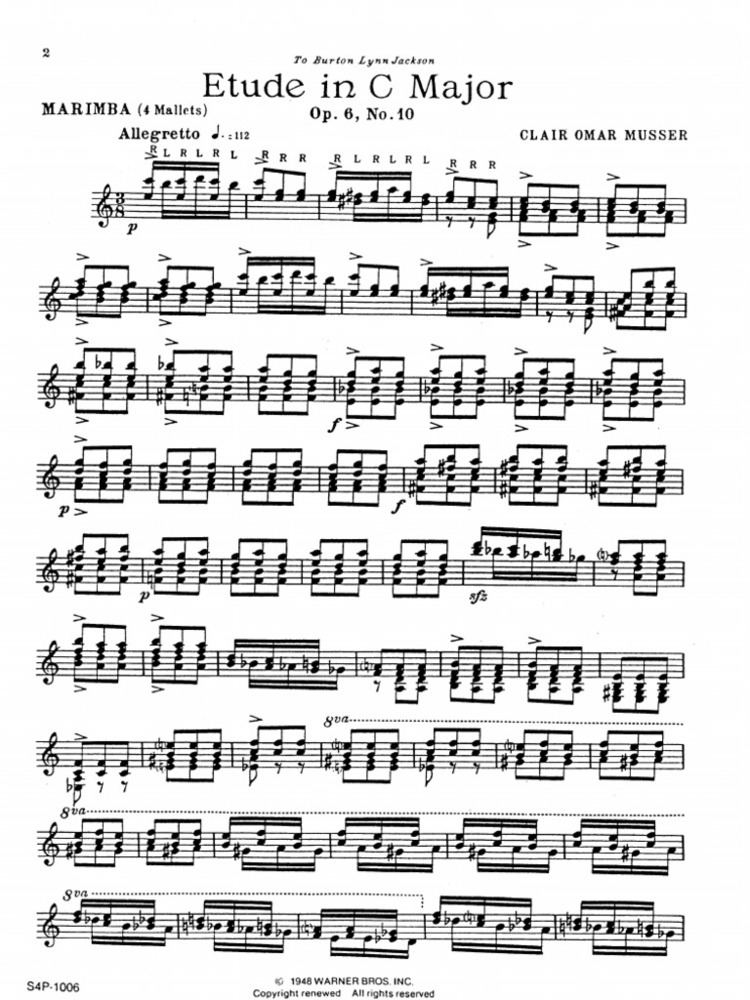Name Clair Musser | Education University of Oxford | |
 | ||
Died 1998, San Fernando Valley, California, United States Similar People Gordon Stout, Leigh Howard Stevens, Keiko Abe, Paul Smadbeck, Mitchell Peters | ||
Etude opus 6 no 9 b major by clair omar musser perform by orlando cotto
Clair Omar Musser (1901–1998) was a marimba virtuoso, a conductor and promoter of marimba orchestras, a composer, a teacher, a designer of keyboard percussion instruments, an inventor, and an engineer for Hughes Aircraft.
Contents
- Etude opus 6 no 9 b major by clair omar musser perform by orlando cotto
- Etude Op 6 10 C Major by Clair Omar Musser Marimba Literature Library
- Early career
- Design Work
- The Marimba Orchestra
- The Deagan Company
- Musser Marimbas
- Northwestern
- Compositions
- The Musser Grip
- EngineeringAstronomy
- References

Etude Op. 6, #10 (C Major), by Clair Omar Musser - Marimba Literature Library
Early career

Musser was born in Pennsylvania and began to study the xylophone in the 5th grade. Upon witnessing a performance of Teddy Brown playing marimba with the Earl Fuller's Rector Novelty Orchestra, Musser was inspired to study with Brown's former teacher, Philip Rosenweig. Musser soon became recognized as a virtuoso in his own right, performing as a soloist, with orchestras, and in an early Warner Bros. Vitaphone film.
Design Work

Musser's first major project as a designer was a unique instrument called the Marimba-Celeste, built at the J.C. Deagan, Inc. factory in Chicago. Essentially, the instrument combined a marimba and a vibraphone, with a built-in amplification system for the lower marimba keys. Musser toured with this instrument between 1927 and 1930.
Some time between 1949 and 1950, Musser designed and built a predecessor to the drum machine, alliteratively called the "Musser Maestro Marimba Metron", or more simply the "Rhythm Machine." The machine, used by Musser to accompany performances and lessons, measures 1.5 feet wide and about 3 feet square. Manufactured using vacuum tube technology, it plays 13 electronically generated rhythmic accompaniments such as the bolero, waltz, rhumba, cha-cha, tango, samba, and beguine. In addition to the pre-set loops, percussion sounds can be activated using push-button controls, which show wear from Musser operating them with his mallets while playing.
Musser's final design project was the Celestaphone, an instrument which served to merge Musser's interests in outer space and music. The frame and the bars were forged from 678 pounds of meteorites from Musser's own collection, which he began gathering from all over the world in 1936. In design and appearance it most closely resembles a pedal glockenspiel.
The Marimba Orchestra
One of the most notable of Musser's contributions to the world of percussion is his work as a conductor and promoter of large marimba orchestras. One of the first of such groups was a 25 piece, all-girl marimba ensemble for a Paramount Pictures event in Chicago. In 1933 at the Century of Progress International Exhibition in Chicago, Musser conducted a marimba orchestra of 100 players. A special marimba, the "Century of Progress Model" was designed by Musser and produced by the Deagan company. Most of Musser's future marimba orchestras would follow a similar model. That is, Musser would select players, arrange and write the music, rehearse and conduct the orchestra, and design a special instrument for the group. The largest group Musser assembled was an orchestra of 300 marimbas appearing at the Chicago Railroad Fair in 1950.
The Deagan Company
Musser joined the J.C. Deagan Company in 1930 as manager of the mallet instrument division. Perhaps the most significant development of Deagan instruments under his leadership was in the area tuning. Marimbas and xylophones to this point had a reputation for sounding "out of tune" due to certain inherent features of their design in the absence of modern acoustical theory. Musser was a member of the Acoustical Society of America and the Society for the Advancement of Science. He understood Fourier's theorem and the applications of that theorem to the tuning of a marimba bar. This understanding allowed Musser and the technicians at Deagan to tune not just the fundamental, but also the harmonics of the bar, creating a clear and unmuddled pitch.
Musser Marimbas
Following World War II, Musser left the Deagan Company to start his own firm, Musser Marimbas, Inc. In addition to marimbas, the company made vibraphones, xylophones, glockenspiels and chimes. Business accumen was not one of Musser's strengths, and the company was sold to Lyons Band Instrument Manufacturers in 1956. The Musser company was sold to Ludwig Drum company in 1965; the latter was sold to Selmer in 1981. Musser's design work, from the bars to the frame, helped to refine and standardize the marimba, although Keiko Abe and Yamaha are largely responsible for the concert marimba as we know it today.
Northwestern
Musser founded the marimba studies program at Northwestern University, the first of its kind, and headed the department from 1942 until 1952. There he instructed many outstanding marimba artists and teachers, including Vida Chenoweth.
Compositions
Musser's work as a composer spanned his entire career, though much of that work has been lost. As of 1941 he had published fifty-three works, including piano solos, sacred music, and arrangements for marimba and vibraphone. The only Musser originals that survive today are:
Those pieces remain standard repertoire for students and professionals alike. Musser assigned an opus number to 10 works at a time, and then began a new set. Since we know of works up to opus 11, it can safely be assumed that over 100 works have been lost. Musser was known to be somewhat disorganized and careless in certain matters, and with his etudes he would simply write one for a student, hand out the original, and think nothing more of it. Two of Musser's other surviving works are arrangements from his marimba orchestras. Rosales' "Bolero" from the 1933 Century of Progress Orchestra, and Saint-Saëns' "Piano Concerto no. 2" from a 1942 performance by a 160-piece marimba orchestra at Soldier's Field in Chicago.
The Musser Grip
Musser developed the Musser grip, a new technique for playing the marimba with four mallets that differed significantly from the already existing cross grip. The musser grip allowed for greater independence between individual mallets, and would later be modified into its modern form by Leigh Howard Stevens.
Engineering/Astronomy
Musser entered into a career as a scientist after leaving Northwestern in the early 50's. He moved to Southern California in and began to do work in astronomy for Hughes and for NASA. He also developed classroom planetaria and other teaching materials which can be found at Cape Kennedy, the Air Force Academy, Griffith Observatory, and many schools and universities. Later he earned a doctorate in engineering from Oxford University.
